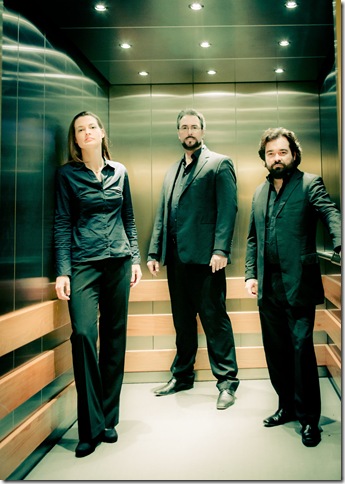The Atos Trio of Germany gave an immaculate concert of music by Rachmaninov, Josef Suk and Franz Schubert in the Flagler Museum’s music series Feb. 18.
The Rachmaninoff and Suk pieces were written when both composers were mere teenagers, but their music is anything but sophomoric; it is well-developed, tuneful and one might say, masterly in structure. Kudos to the Atos Trio for bringing these early works to our attention.
Founded in 2003 by violinist Annette von Hehn, who invited pianist Thomas Hoppe and cellist Stefan Heinemeyer to join her, the Atos took not only the first prize at the 5th Melbourne International Chamber Music Competition in Australia, but also the grand prize. Similarly, they won the Kalichstein-Laredo-Robinson Award in 2007, which offered 20 important concerts around the United States, including Carnegie Hall.
The Rachmaninov Trio Elegiaque, written in 1892 while he was a student at the Moscow Conservatory, begins silently as the cello and violin quietly stroke their strings. A clean statement from the piano leads to a double forte tune from all three instruments. It’s a lovely melody repeated by the violin. All pick up this thrilling, expansive theme, leaving the piano, naturally, to make the most of it.
The hardworking pianist transitions into a softer, mellower romantic mood, where the violin plays some lovely music and is joined by the cello in a stronger theme, all while the pianist plays terrifically thrilling scales. The expressiveness of this work indicates early mastery of his technique, although it is in one long movement, not the usual three, the 19-year-old Rachmaninoff possibly had his friend and mentor, Tchaikovsky, in mind when he composed it.
Josef Suk was perhaps overshadowed by his father-in-law, Antonin Dvořák. It’s a pity more of his considerable lyrical works are not scheduled by U.S orchestras. Tellingly, the Czech record company Supraphon recorded many of his compositions in the 1960s, when Prague was overrun by the Soviet military. The work heard Feb. 18 was his Piano Trio (Op. 2), written when he was 15 years old. At 11, he had been admitted to the Prague Conservatory continuing a family tradition of several generations. His own son, also Josef, followed him there. Founder of the Czech and Bohemian string quartets, he played “second fiddle” in both for almost 40 years.
The first movement begins with a thrilling start as descending chords are answered by ascending notes in dotted rhythm, richly played. This is the work of a brilliant teenager. The Andante begins slowly, rather dance-like, with wonderful solos from each instrument. The pianist’s light touch is very impressive. The thread of Atos’s lovely playing keeps one’s interest riveted.
The third movement, Vivace, has a lively start and exquisite playing from the solo violin, whose sounds are strong and sweetly lyrical at the same time. Magnificent crescendos and rallentandos abound. A change of key gives the wonderful cellist a chance to shine, and shine he does as he hugs his instrument so that he and it appear to be as one.
After intermission, it was the turn of the king of Leider, Franz Schubert, who referenced his 1825 song, Des Sängers Habe (The Singer’s Possessions), many times over in his Trio No. 1, written in 1828. The opening has an astonishing likeness to his famous Trout Quintet, with its flashy piano playing in and around the strings. The cello plucks away as the violin and piano trill away at the melody. Bold scurrying triplets of Schubert repeat and repeat the original opening. Expressive lyricism winds two tunes together seamlessly. At the end of the Allegro moderato the cello shone brightly in the return to the original theme.
The second movement (Andante un poco mosso) “is a dream of bliss, a pulsing flow of human emotion,” as Robert Schumann wrote in reference to it. Brilliant playing from the cello leads the way, and sharp attention is paid by the pianist as he listens for his cues. The violin has an exquisite solo accompanied by the piano, cello joins in later. These three fine musicians made sensuous melancholy music together.
The Scherzo-Allegro has more lovely Schubert tunes passed around, with a question-and-answer duet between piano and violin. The cello is at the forefront of the movement announcing the expressive theme. After the initial subject, which is transformed, it returns back to the original theme.
Lastly the Rondo (Allegro vivace): Great long chords in unison announce the joy this trio has been so far. Tripping dance-like tunes galore are played richly as all three articulate the main subject. There’s a quiet build-up to a triple note repeat on the violin, suggesting the end is in sight. Not yet. Schubert teases his listeners with this violin theme four or five times. At last a few dramatic chords signal the end is near. Terrific piano scales hurtle through the air as a plucked cello ends the movement.
For the first time in my experience at these concerts, the audience rose as one with a standing ovation. Applause was loud and long.
The 2014 Flagler Museum series closes Tuesday, March 4, with an appearance by the Talich Quartet. The Czech foursome will play two Czech works, the First Quartet of Bedrich Smetana (From My Life), and the Quartet No. 10 of Antonin Dvořák. Also on the program is Joaquin Turina’s Bullfighter’s Prayer. The concert starts at 7:30 p.m. Tickets are $60 (includes champagne reception). Call 655-2833 or visit flaglermuseum.us.
